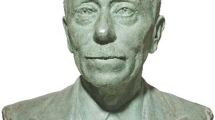Abstract
This paper outlines the historical evolution of the concept of chemical affinity that eventually supported the concept of chemical equilibrium. It provides the theoretical roots that grounded the following four key basic ideas of chemical equilibrium: ‘reversibility’, ‘incomplete reaction’, ‘equilibrium constant’ and ‘dynamic equilibrium’. The starting point of this historical reconstruction is the state of the art in the elaboration of the first affinity tables, based on the concept of elective affinities, during the eighteenth century. It is discussed how Berthollet reworked this idea, considering that the amount of the substances involved in a reaction was an essential factor determining its direction, which accounted for the early concepts of incomplete reaction and reversibility. Guldberg and Waage considered the concentrations of the chemicals involved, instead of their mass and formulated the first mathematical equations accounting for chemical equilibrium reactions. Afterwards, it is presented how Pfaundler provided the seminal ideas concerning a dynamical molecular interpretation of the macroscopic properties of equilibrium reactions. This material is intended to serve as a supplementary reading for an introductory course in physical chemistry.


Similar content being viewed by others
Notes
Two English translations are available: (a) Concerning the different affinities observed in chemistry between different substances In: Leicester HM, Klickstein HS (1963) A Source Book in Chemistry, 1400–1900. Harvard University, Cambridge, MA, 67–75; (b) Geoffroy EF (1996) Table of the different relations observed in chemistry between different substances, Science in Context 9:313–319. The quotations given in this paper refer to the first one.
Page 68.
Page 68.
Page 11.
Pages 6–7.
Page 199.
Page 199.
Page 199.
Page 74.
Page 1045.
Page 1046.
Page 7.
Page 10.
Page 74.
Page 303.
Page 303.
Page 24.
Translated: Pfaundler L (2011) A Contribution to Chemical Statics, Bull Hist Chem 36(2):87–97. The quotations given in this paper refer to this recent translation.
Page 88.
References
Geoffroy EF (1718) Table des Differents Rapports Observés en Chimie entre Differentes Substances, Memoires de l’Académie Royale des Sciences 202–212
Bergman T (1785) A Dissertation on Elective Attractions, (2nd Edn). Frank Cass & Co Ltd, London
Weller SW (1999) Napoleon Bonaparte, French Scientists, chemical equilibrium, and mass action. Bull Hist Chem 24:61–65
Leicester HM, Klickstein HS (1963) A source book in chemistry, 1400–1900. Harvard University, Cambridge
Gay-Lussac LJ (1816) Observations sur l’oxydation de quelques métaux. Crochard, Paris
Gay-Lussac LJ (1839) Considerations sur les Forces Chimiques. Annales de Chimie et de Physique 70:407–434
Malaguti MJ (1853) Exposition de Quelques Faits Relatifs a l’Action Réciproque des Sels Solubles. Annales de Chimie et de Physique 37:198–206
Gladstone JH (1855) On circumstances modifying the action of chemical affinity. Philosophical Transactions 145:179–223
Gladstone JH (1857) Some experiments illustrative of the reciprocal decomposition of salts. Q J Chem Soc 9:144–156
Ostwald W (1914) L’Évolution d’une Science: la Chimie. Flamarion, Paris
Guldberg CM, Waage P (1867) Études sur les Affinités Chimiques. Christiania University, Oslo
Waage P, Guldberg CM (1962) (Translated by Abrash, H.I.) Studies concerning affinity. J Chem Educ 63:1044–1047
Ostwald W (1980) Outlines of general chemistry. MacMillan, London
Lund EW, Hassel O (1964) Guldberg and Waage and the law of mass action In: Bastiansen O (ed) The law of mass action. A centenary volume, 1864–1964. Det Noske Videnskaps-Akademi Oslo, Oslo, pp. 37–46
Lund EW (1965) Guldberg and Waage and the law of mass action. J Chem Educ 42:548–549
Laidler KJ (1995) The world of physical chemistry. Oxford University Press, Oxford
King MC (1981) Experiments with time: progress and problems in the development of chemical kinetics. Ambix 28:70–82
Guldberg CM, Waage P (1879) Über Die Chemische Affinität. J Prakt Chem 127:69–114
Lemoine MG (1882) Études sur les Équilibres Chimiques. In: Fremy M (ed) Encyclopédie Chimique, Tome I. Dunod, Paris, pp 69–372
Williamson AW (1851) Suggestions for the Dynamics of Chemistry Derived from the Theory of Etherification, Notices of the Proceedings at the Meetings of Members of the Royal Institution 1:7–24
Pfaundler L (1867) Beiträge zur Chemischen Statik. Ann Phys 131:55–85
Author information
Authors and Affiliations
Corresponding author
Rights and permissions
About this article
Cite this article
Quílez, J. The historical development of the basic ideas concerning chemical equilibrium. ChemTexts 3, 3 (2017). https://doi.org/10.1007/s40828-017-0040-1
Received:
Accepted:
Published:
DOI: https://doi.org/10.1007/s40828-017-0040-1




